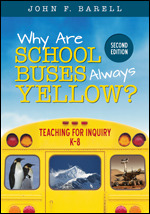Why Are School Buses Always Yellow?
Teaching for Inquiry, K-8
- John F. Barell - Education Consultant
Corwin Teaching Essentials
Turn natural curiosity into deep, lasting learnings!
Inquiry is what drives us all toward new knowledge, but how do we transform children’s natural ability to notice and wonder into the full learning cycle of observing, thinking, and critically questioning?
Through this new edition of the bestselling Why Are School Buses Always Yellow? you’ll find simple, yet systematic ways to develop authentic student inquiry that fosters deep learning. This new edition features:
- Updates based on the latest research around inquiry-based teaching
- Emphasis on turning inquiry into critical thinking, assessing students’ inquiry, and involving families in the inquiry process
- Examples for K–8 across subject areas
- New emphasis on critical thinking about technologies
- New and updated activities, checklists, templates, and implementation tools
- Alignment with Common Core and Next Generation Science Standards
With this invaluable resource, help students transform their playful wonderings into deeper questions about content—and develop the higher-level thinking skills they need for success in school and in life.
"Educators often talk about developing lifelong learners - our team has had great success using Why Are School Buses Always Yellow? to catalyze professional conversations about how we can better cultivate curiosity through an inquiry approach. I strongly recommend this [new edition] for those who are interested in unlocking the uniquely creative capacity of our youngest learners."
Devin Vodicka, Superintendent
Vista Unified School District, Vista, CA
"Why are School Buses Always Yellow? ignited a fire in our school. With only small tweaks to our units, our teachers saw huge differences. The students were so excited and eager to learn. We have continued to build on that success with a focus on inquiry and Barell’s words of wisdom are often quoted during planning sessions."
"Educators often talk about developing lifelong learners - our team has had great success using Why Are School Buses Always Yellow? to catalyze professional conversations about how we can better cultivate curiosity through an inquiry approach. I strongly recommend this book for those who are interested in unlocking the uniquely creative capacity of our youngest learners."
"John discusses simple ways to develop authentic student inquiries using real life examples from teachers around the world illustrating the power of the curious mind in all of us. The new chapter on evaluating sources in the digital age is particularly pertinent for our students. John inspires educators to ensure inquiry drives student learning in the classroom and beyond."
"Questions give voice to wonderings and provide purpose to learn and broaden horizons. Superbly demonstrated within these covers is the understanding that inquiry is for all – no matter the interest or academic level. How is this possible and achievable? Open this book to discover ideas that can be easily adapted to any learning environment."
- Updated to reflect the newest research.
- New stories and examples, broadened to grades K through 8.
- Discussion and alignment of the inquiry process with Common Core State Standards and Next Generation Science Standards.
- New chapter on how to use technology to pursue inquiry and also build professional practice
- Each chapters has new "Try this!" activities, new graphics, and updated checklists, templates, reflection questions with room for notetaking, a glossary of key terms, and other implementation tools
